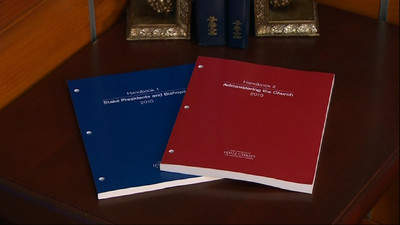Question
Gramps,
What is the church’s understanding or belief in regards to the spear of destiny. Do we believe in its existence? I’m pretty sure we don’t believe in its “power.” Please enlighten me.
Court
Answer
Dear Court,
Like many objects in sacred history, there was a physical, tangible, real spear that pierced our deceased Lord’s physical, tangible, real side (John 19:34). In this respect it joins the ranks of such religious artifacts as the ark of the covenant, the Liahona, the brass serpent, or the Urim and Thummim. All of these objects have wonderful histories associated with them that sound more like fantasies. The ark circled the city of Jericho and brought the walls down. Although it’s sometimes called a compass, the Liahona pointed the direction Lehi’s family needed to go, regardless of magnetic north or even the ultimate destination. The brass serpent healed on mere sight (how’s that for medicine?). The Urim and Thummim give the viewer the ability to translate ancient records regardless of language. And the spear of destiny purports to bend people’s wills and events to the bearer’s favor.
And that’s about as far as the similarities go. Looking over the list, you’ll note that only the spear of destiny lacks scriptural documentation of miraculous power. The holy record testifies only of its role in the Crucifixion. One other stark contrast between the legend of the spear and the other relics is what happens when the object falls into the wrong hands. In the hands of Israel’s enemies, the ark of the covenant became a curse (and it certainly didn’t aid them in times of disobedience). And poor Uzzah learned that it was not to be treated lightly. The Liahona left Lehi’s seafaring family at the mercy of the waves when they became riotous and raucous. Joseph Smith learned that the Urim and Thummim would not work for a hostile or agitated mind. “One morning when [Joseph] was getting ready to continue the translation, something went wrong about the house and he was put out about it. Something that Emma, his wife, had done. … He could not translate a single syllable. He went down stairs, out into the orchard, and made supplication to the Lord; was gone about an hour–came back to the house, asked Emma’s forgiveness and then came up stairs where we were and then the translation went on all right. He could do nothing save he was humble and faithful” (David Whitmer, interview by William H. Kelley and George A. Blakeslee, Sept. 15, 1881, Saints’ Herald,Mar. 1, 1882, p. 68).
In contrast, the spear of destiny is rumored to leant strength to such notorious conquerors of that past as Charlemagne, Alaric, and even Hitler. Claims are made that the mere possession is sufficient for conquest. That sounds nothing like the items I just listed. The closest you get to it is the brass serpent, which required only a look to claim its miraculous benefits. And that’s where a cautionary tale comes to us about this spear.
The brass serpent was a mere foil. By looking at it, you were really tacitly acknowledging Moses’ authority as prophet for the Lord who created all things: even serpents; even yourself. As such there was an implied faith in the Lord’s power. Years later, this lesson escaped the Israelites, and they came to see the artifact as something of power in and of itself. In the reign of Hezekiah, “the children of Israel did burn incense to it“, so he broke it up. The Israelites had forgotten that their God who would one day be raised up like the serpent was the real healer. The Man is greater than the shadow.
In this light, it’s probably best to refer to it as Longinus’ spear (the traditional name of the soldier) rather than the spear of destiny (which comes loaded with superstition). The lesson from the brass serpent should remind us that the pierced God is greater than the lacerating instrument. The atoning blood of Jesus has greater power for changing the world than any lance that spilt it.







